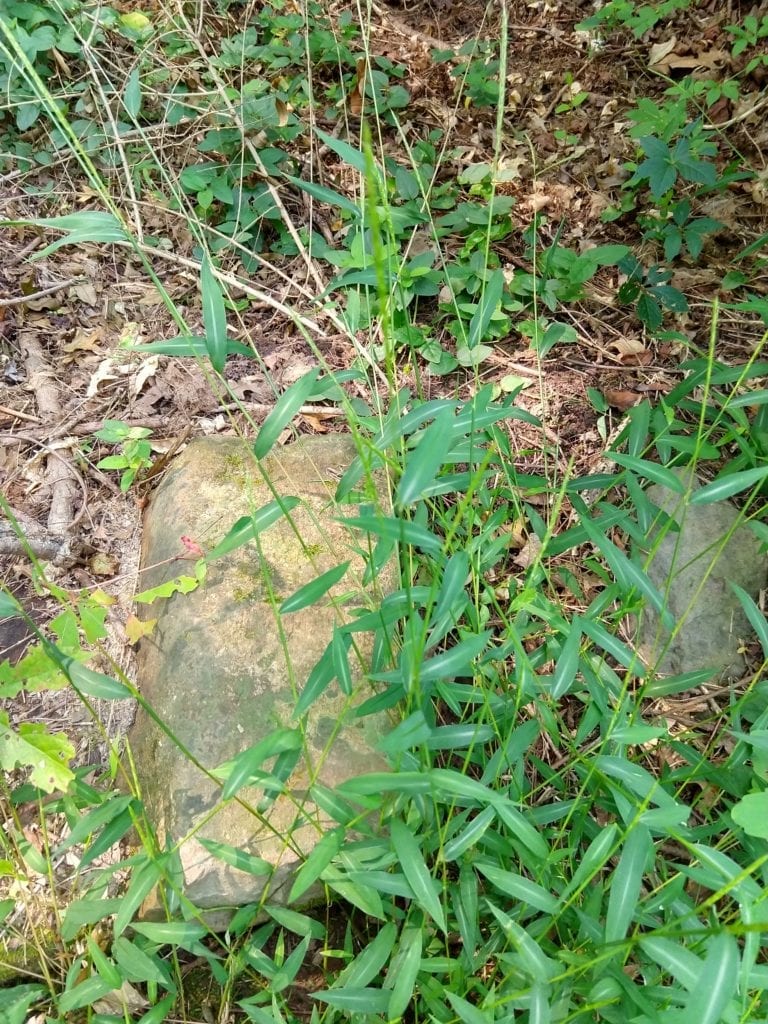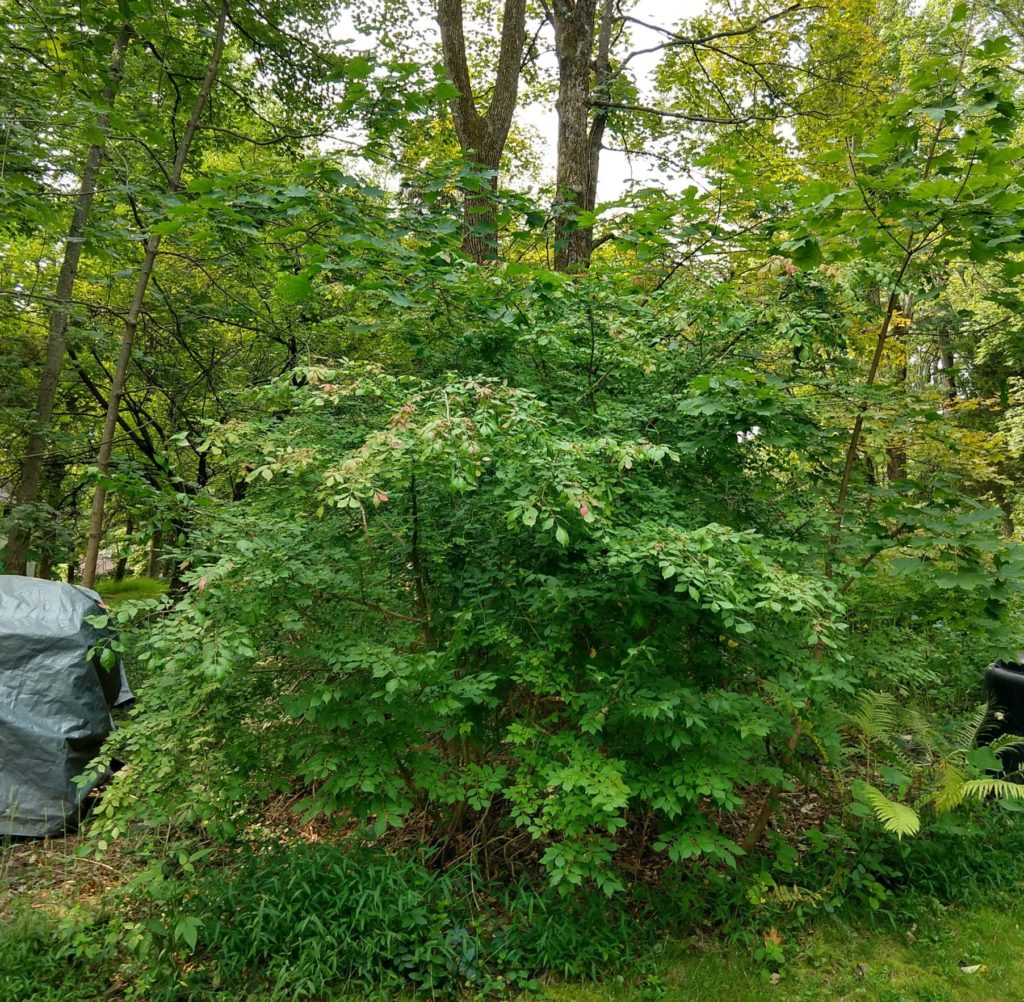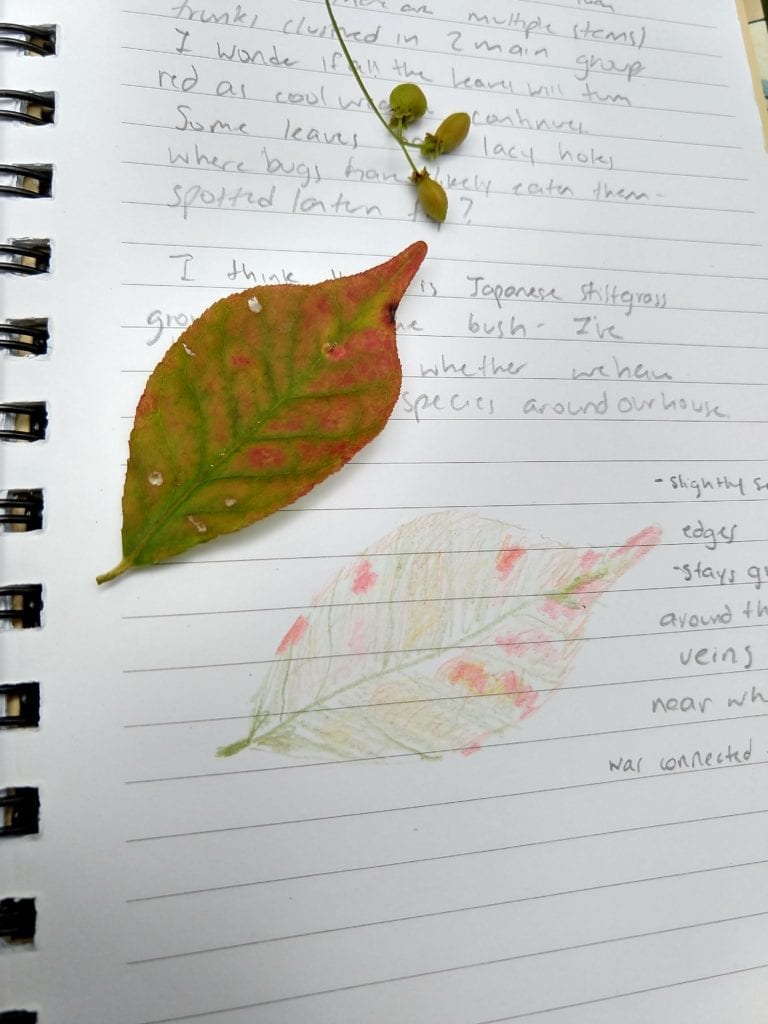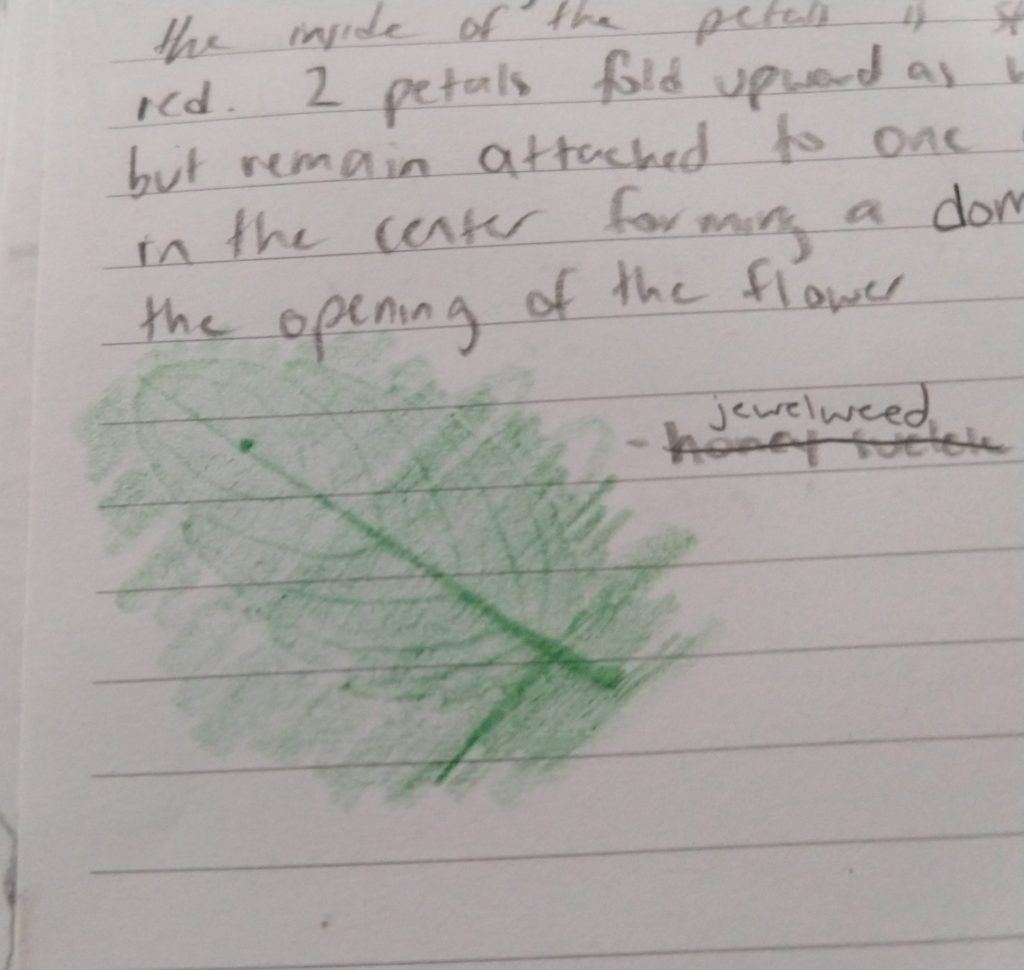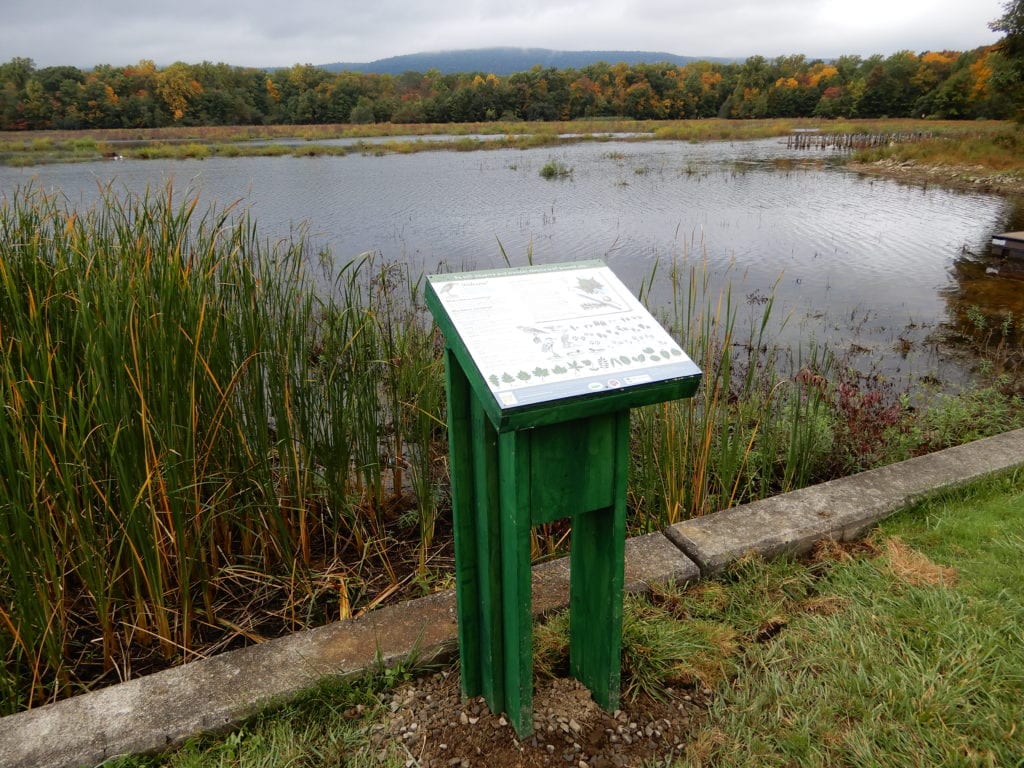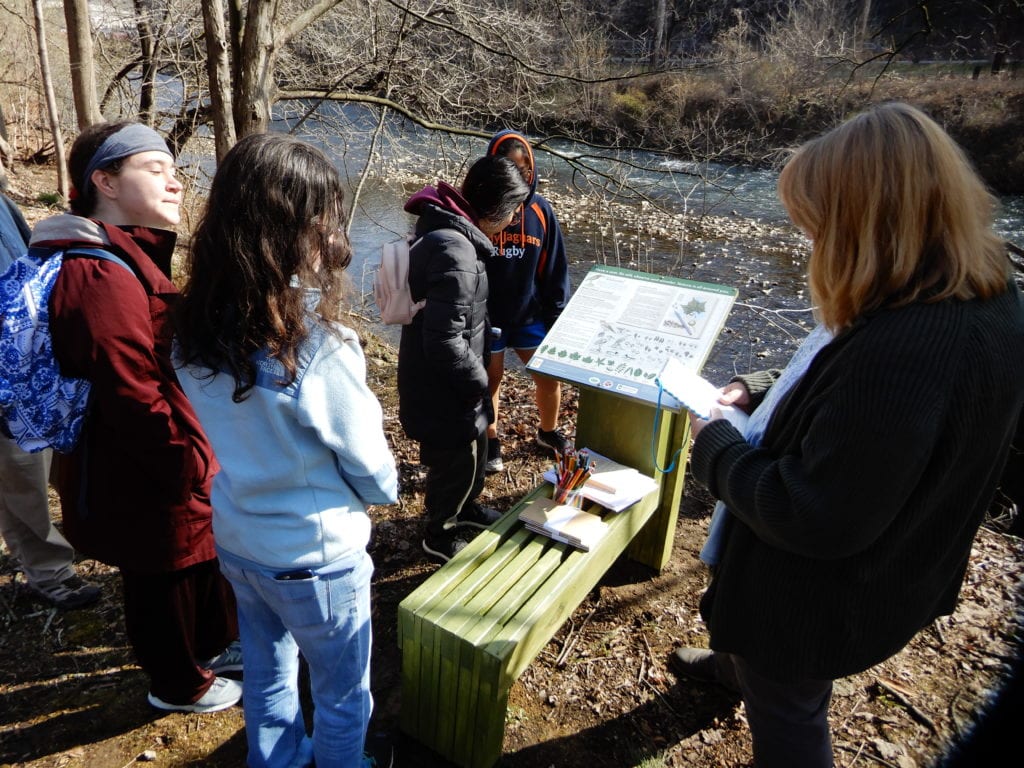Nature journaling is described as one way of improving observation and documentation skills, connecting to nature, and taking care of one’s mental and emotional health. Reading about these benefits, however, is very different from experiencing them personally, so I decided to try out nature journaling for one week and reflect on what it was like for someone trying it out for the first time.
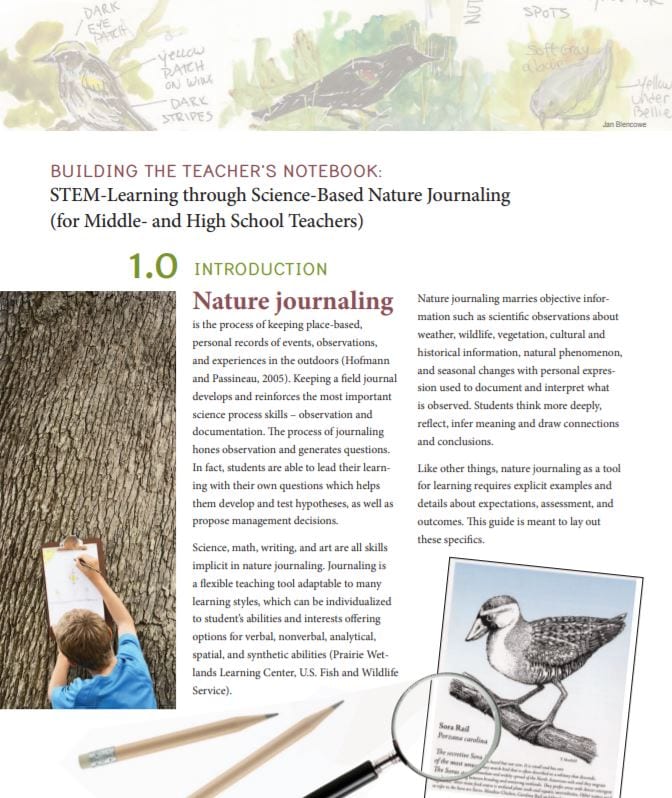
NNC’s Nature Journaling Guide contains helpful tips for both teachers and those looking to try nature journaling themselves.
The first step was to learn what exactly nature journaling entails. NNC has published a Nature Journaling Guide, and our Art Director Keri Maxfield shared some tips in this blog post. The guide states that nature journaling or keeping a field journal “is the process of keeping place-based, personal records of events, observations, and experiences in the outdoors.” Keri recommends beginning each entry with the date and time of day, where you are (schoolyard, backyard, garden, park), the weather, and what the landscape looks like (rocky, grassy, trees). From there, entries can include notes, drawings, leaf rubbings, physical items (rocks, leaves, shells, etc.), photographs, and more. Looking at examples was very helpful for me in thinking of what types of things to observe and creative ways to record what I saw. You can find sample prompts to inspire your own nature journaling in Keri’s blog post and from Project Learning Tree.
The Experience
The first day I nature journaled, I hadn’t read through NNC’s guide yet, and went in a little bit blind. I had just planted a hawthorn tree that weekend in my yard, so I sat by it and just wrote whatever came to mind as I observed the tree and garden. This was my shortest entry of the week, and I wasn’t sure where to go from there the next day. Reading the guide and looking at other examples of natural journal pages encouraged me to be much more detailed and record specifics of what I saw. As cooler weather set in and it started to feel more and more like fall, I was interested in looking for signs of the seasons changing. From my office window I can see a tall shrub that was one of the first plants to
begin to change colors, turning a bright orange-red color on some of the leaves. I decided to make that the object of my second day’s entry, and recorded the structure of the leaves and berries, took a leaf rubbing, noticed that the bush had multiple stems emerging from the ground, and did my best to document the coloration of one of the leaves that was starting to transition from green to red. From this information, I hoped to be able to go back and identify the species of shrub later. While I was walking around the bush, I noticed a grassy plant growing underneath it that I recognized as Japanese stiltgrass, an invasive species. I had been wondering whether it was present on our property, but hadn’t gone out looking for it before.
The leaves of this shrub slowly turning red caught my eye from my office. My art skills aren’t very developed, but I traced a leaf and tried to document its coloration.
I enjoyed the experience of picking a specific organism or at least area to focus my observations, so I took a similar tack for the next couple of days. I had better luck identifying the next plant that caught my eye, which was a flowering spindly plant about 1-2’ high growing in the wooded area next to my yard. From the leaf rubbing I took and the description of the flower I recorded, I searched the internet and found it matched descriptions for orange or spotted jewelweed, also known as touch-me-not.
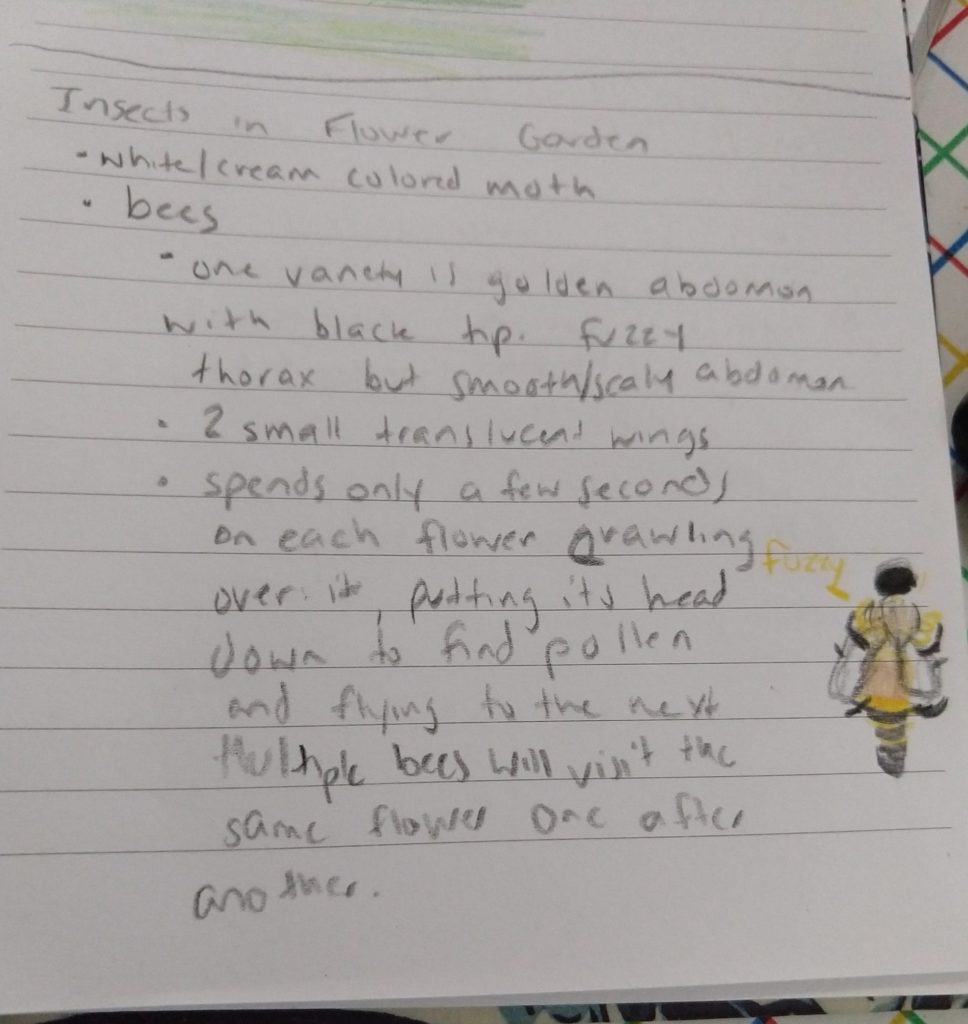 By this point, I wanted to look at something other than plants. As I stepped outside, I thought about looking for a tree trunk or section of the ground where there might be ants. While I considered where to check first, a buzz arising from a flowering bush in the garden caught my attention. I decided to observe the bees and any other insects I saw as they visited the flowers to collect pollen. I logged each type of insect I saw – one moth, 2 types of bee, and 1 small species of fly or bee. I wrote out descriptions for them and drew a picture of the most common type of bee I saw. It was really interesting to me to spend time observing something that I had walked past without a second glance all summer.
By this point, I wanted to look at something other than plants. As I stepped outside, I thought about looking for a tree trunk or section of the ground where there might be ants. While I considered where to check first, a buzz arising from a flowering bush in the garden caught my attention. I decided to observe the bees and any other insects I saw as they visited the flowers to collect pollen. I logged each type of insect I saw – one moth, 2 types of bee, and 1 small species of fly or bee. I wrote out descriptions for them and drew a picture of the most common type of bee I saw. It was really interesting to me to spend time observing something that I had walked past without a second glance all summer.
Takeaways
- Especially relevant in our current times, I found that the stress-relieving effects of being in nature and the act of journaling helped to calm me and give a moment of rest from thinking about everything going on in the world. For me, the more specific I was in my journal observations, the more I was able to let go of whatever I had been thinking about before I started and focus on what I was observing. This shouldn’t have come as a surprise for me because I have a pretty analytical mind and like to document and organize things. This will be different for everyone – find what feels like the natural way for you to record what you’re seeing and lean into that.
- Getting started can be hard, but once you’re started it’s stopping that becomes difficult! There were a couple of days when I really wasn’t sure where to go outside or what to document. However, when I just picked something and started journaling, even if it was as simple as one plant or flower, that would lead me to another observation, and another, and I felt like I could have just kept going to record a full picture of the nature in my own yard.
- On a related note, nature journaling doesn’t require you to go to the middle of the woods or a stream bank or any special location, although that’s certainly an option. I did all of my entries around my house, either looking at nearby wooded areas or my garden. Even a container garden, lawn, or the cracks in a sidewalk could be home to plants, insects, or small animals to observe. Or, look up! Nature journaling can record the sky, clouds, weather, and anything else about the world around you.
- Even as someone who loves the outdoors, this week made me realize how disconnected from the natural environment around me I usually am. I only know the names of a few of the species surrounding my house, and I know relatively little about their growth cycles and how they change through the year. Beginning to explore some of that information through journaling made me wish I was more immersed in those topics, and also felt like a great first step in starting to build that familiarity and knowledge. Similarly, I could imagine how this experience would become richer over time if I nature journaled regularly – I’d start to have records of patterns and trends in the environment around me, and could observe changes throughout the seasons and from year to year.
Nature journaling was a far more mentally stimulating exercise than I thought it would be from just reading about it. Going outside to observe a natural setting and write down what you see sounds deceptively simple, but when I actually started journaling I found myself looking for patterns, learning new things, and discovering questions that I wanted to seek out answers to. Exploring the world around me in this intentional way drew me in to the details of where the fruits grow on the bush I observed or how the coloration on different types of bees varies. It was a reminder that humans and all of the issues we may experience on a given day – whether a pandemic, political unrest, or just stress over an upcoming deadline – do not make up the full story of life on Earth. There’s an entire other world right under our noses that we rely on and are a part of, and I found deepening my connection to that world through nature journaling to be a very rich and valuable experience.
If you’d like to try nature journaling for yourself, Nurture Nature Center has installed nature journaling stations at three locations in and around Easton. They are along the Lehigh River at Hugh Moore Park, the Delaware River at Scott Park, and the Bushkill Creek along the Karl Stirner Arts Trail. Our design for the stations was used for an expansion of the project at Minsi Lake, where 5 more stations were installed as an Eagle Scout project.

